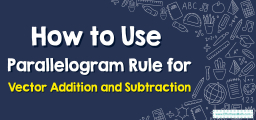How to Grasp Parallel Vectors
Parallel vectors are vectors that have the same or opposite direction. In simpler terms, they point along the same straight line in space. It's essential to note that the magnitude (or length) of the vectors doesn't have to be the same for them to be parallel; only their direction must be consistent.

Step-by-step Guide to Understand Parallel Vectors
Here is a step-by-step guide to understanding parallel vectors:
Step 1: Setting the Stage – The Alluring World of Vectors
Venturing into the realm of vectors, we encounter entities with both magnitude and direction. These celestial arrows float in space, guiding us through mathematical challenges.
- The Birth of a Vector:
- Born from necessity, vectors are the heart and soul of linear motions. Represented visually as directed arrows, they possess both direction and magnitude.
- E.g., \(\overrightarrow{V}=V_xi+V_yj\) (in \(2D\) space).
Step 2: The Crux – What Does ‘Parallel’ Really Mean?
Parallel vectors, in the abstract landscape of mathematics, are vectors that flow harmoniously in the same or opposite directions, never deviating from their shared path.
- The Geometrical Insight:
- Two vectors are parallel if they lie along the same line or their corresponding lines are equidistant at all points. In simpler terms, they point in the same or exactly opposite directions.
- The angle between parallel vectors is either \(0^\circ\) (same direction) or \(180^\circ\) (opposite direction).
- Algebraic Aura:
- Vectors are parallel if one is a scalar multiple of the other.
- If \(\overrightarrow{A}\) and \(\overrightarrow{B}\) are parallel, there exists a scalar \(k\) such that: \(\overrightarrow{A}=k\overrightarrow{B}\) or \(\overrightarrow{B}=k\overrightarrow{A}\).
Step 3: The Dot Product Divulgence
The dot product can offer a secret passage to discern if two vectors are parallel.
- Recollection:
- For vectors \(\overrightarrow{A}\) and \(\overrightarrow{B}\), the dot product is: \(\overrightarrow{A}⋅\overrightarrow{B}=\overrightarrow{∣A∣} \ \overrightarrow{∣B∣}cos(θ)\)
- Decoding Parallelism:
- If vectors are parallel, \(cos(θ)\) is either \(1\) or \(-1\).
- Thus, if \(\overrightarrow{A}⋅\overrightarrow{B}=\overrightarrow{∣A∣} \ \overrightarrow{∣B∣}\) or \(\overrightarrow{A}⋅\overrightarrow{B}=−\overrightarrow{∣A∣}\ \overrightarrow{∣B∣}\), then \(\overrightarrow{A}\) and \(\overrightarrow{B}\) are parallel.
Step 4: The Cross-Product Conundrum
In a \(3\)-dimensional space, the cross-product provides another tantalizing technique.
- Recollection:
- For vectors \(\overrightarrow{A}\) and \(\overrightarrow{B}\), the cross-product results in a vector perpendicular to both.
- Its magnitude is ∣\( \overrightarrow{A}×\overrightarrow{B}\)∣\(=\overrightarrow{∣A∣} \ \overrightarrow{∣B∣}sin(θ)\).
- Deciphering Parallelism:
- If vectors are parallel, \(sin(θ)\) is \(0\).
- Hence, if \( \overrightarrow{A}× \overrightarrow{B}= \overrightarrow{0}\), then vectors \( \overrightarrow{A}\) and \( \overrightarrow{B}\) are parallel.
Step 5: The Elegant Dance of Parallel Vectors in Applications
- Physics: Parallel vectors often represent forces acting in sync or collinear displacements.
- Computer Graphics: Vectors play a role in transformations, where preserving parallelism ensures objects don’t get distorted.
- Geometry: Recognizing parallel vectors helps in proofs and constructions, ensuring congruency and similarity.
Step 6: Conclusion & Reflection
In the vast cosmos of vectors, parallelism is a poetic notion of harmony, a ballet of vectors moving in tandem. Recognizing this dance requires a blend of geometry, algebra, and intuition. It’s a journey worth undertaking, for the elegance of parallel vectors illuminates many a mathematical path. Embrace the dance, and let the vectors guide your way!
Examples:
Example 1:
Given vectors: \( \overrightarrow{M}=(3,6)\), and \( \overrightarrow{N}=(1,2)\), determine if the vectors are parallel.
Solution:
We must see if one is a scalar multiple of the other. Specifically, for some scalar \(k\), all components of \(k \overrightarrow{N}\) should match those of \( \overrightarrow{M}\).
For the \(x\)-components:
\(k×1=3\)
\(k=3\)
For the \(y\)-components:
\(k×2=6\)
\(k=3\)
Since for both components, the scalar \(k\) is consistent, the vectors are indeed parallel.
Example 2:
Given vectors: \( \overrightarrow{P}=(4,8)\), and \( \overrightarrow{Q}=(−2,−4)\), determine if the vectors are parallel.
Solution:
Again, we’ll check if one is a scalar multiple of the other:
For the \(x\)-components:
\(k×−2=4\)
\(k=−2\)
For the \(y\)-components:
\(k×−4=8\)
\(k=−2\)
Once more, the scalar \(k\) remains consistent across the components. Therefore, the vectors \( \overrightarrow{P}\) and \( \overrightarrow{Q}\) are parallel, albeit pointing in opposite directions.
Related to This Article
More math articles
- 4th Grade FSA Math FREE Sample Practice Questions
- How to Differentiate Trigonometric Reciprocals
- Algebra Puzzle – Challenge 38
- Top 10 3rd Grade MCAS Math Practice Questions
- Top 10 3rd Grade IAR Math Practice Questions
- Decoding the Dynamics: How to Understanding Input/Output Tables
- The Ultimate 6th Grade K-PREP Math Course (+FREE Worksheets)
- 3rd Grade WVGSA Math Worksheets: FREE & Printable
- TABE Math-Test Day Tips
- 10 Most Common ParaPro Math Questions


























What people say about "How to Grasp Parallel Vectors - Effortless Math: We Help Students Learn to LOVE Mathematics"?
No one replied yet.